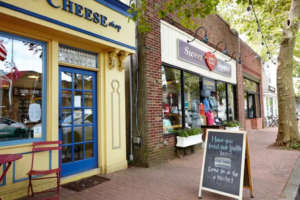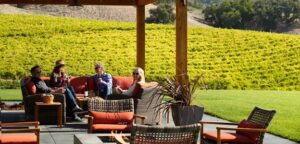The headline might seem a bit facetious. You taste wine on Long Island just like anywhere else: lift glass, swirl, sniff and sip. Sure, but there are wrinkles to wine tasting on the North Fork that are somewhat unique. Before heading out, give some consideration to these issues.
Workers tending the vines at Paumanok Vineyards, where visitors will soon sip wine.
- Try to visit on weekdays. Of course, wineries are busier on the weekends everywhere. But many of them on Long Island work on the presumption that they can make more money from partiers than serious wine drinkers. You can expect to find rock bands, food trucks and a lot of louder than usual people Friday through Sunday. Early in the week, even the most popular wineries are fairly empty, giving more time for individual attention.
- Take off early. If like us you are starting from New York City, you can expect delays on the Long Island Expressway, mostly in leaving Manhattan and putting Queens behind you. Generally, but not always, it’s smoother sailing once you get into Nassau County. (The North Fork is at the extreme east of Suffolk County.)
- Consider making appointments. They are certainly a necessity on weekends, and although we haven’t been turned away on weekdays, we’ve been told by some tasting room managers that they have done so if they find they can’t accommodate walk-ins. Of course, this means you need to know where you are going before you set off, which eliminates serendipity, the delightful discoveries that make wine tasting trips so rewarding.
- Think about lunch. Almost no wineries allow picnicking any longer. Many sell food, but it’s more snacks than meals. There are places to stop for lunch, mostly along Route 25, but only a few where you can dine, rather than grab a quick bite.
- Plan on staying over. We used to take day trips, but then we realized that we were spending four to six hours on the road for four or five hours of tasting. Plus there was the danger of driving back having consumed alcohol. There are many bed-and-breakfasts and some hotels, mostly in Riverhead and Greenport. They can run a bit expensive but an overnight stay really adds to the trip. And it gives you a chance to sample the local cuisine, which leans towards seafood.
- Try places you don’t know. If you’ve never been to the North Fork or last were there many years ago, then everything will be new to you. Today, new owners are buying up familiar wineries and changing their names (and, to an extent, the quality of the wines.) For example, Shinn is now Rose Hill; Laurel Lake is now Ev&Em. Even more so, some people have invested serious money in new wineries. These are often the best places to stop.
- Now, as before, the North Fork offers glimpses of small-town America. You’ll find that spirit in Greenport and Southold. You’ll notice the plethora of churches of every denomination. They are indicative of the roots of many of these towns going back centuries to America’s earliest European settlers. And the names of many of the the towns – Cutchogue, Mattituck, Peconic, Paumanok – evidence the influence of the First Nations.












